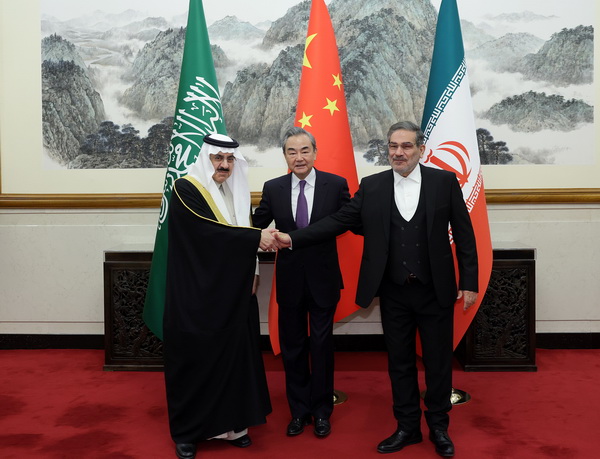Seismic Iran-Saudi Rapprochement Isolates US
CONFLICT RESOLUTION - MEDIATION, 13 Mar 2023
Joe Lauria | Consortium News – TRANSCEND Media Service
The Chinese-brokered diplomatic deal between Saudi Arabia and Iran not only opens the way for resolution of region-wide conflicts, but foils U.S. Mideast divide-and-rule designs based on Saudi-Iranian enmity.
11 Mar 2023 – Ever since the 1979 Islamic Revolution that overthrew the U.S.-allied Shah of Iran, the rivalry between the two major Middle East powers — Iran and Saudi Arabia — has been at the heart of every conflict across the region.
The announcement on Friday that Iran and Saudi Arabia have normalized relations could have a seismic effect on all these conflicts and leave the U.S. on the outside looking in.
In Lebanon, Iranian-backed Hezbollah and Saudi-backed parties might begin to resolve their differences, a unity that would worry Israel and lessen U.S. influence in the country.
In Syria, Hezbollah and Iranian militias have been battling Saudi-backed jihadists for more than a decade. The Syrian war could now come to an end.
In Yemen, U.S.-backed Saudis have been fighting the Houthi, who have been driven into a closer alliance with Iran. Obstacles to a peace deal could now have been removed.
In Iraq, reconciliation between Sunni and Shia could make the U.S. presence and influence irrelevant and unwelcomed by all sides.
In Bahrain, Iranian-backed Shi’ites no longer in conflict with the Saudi-aligned monarchy could sideline the presence of the U.S. Fifth Fleet in a region on the mend.
And in Saudi Arabia itself, the state’s tensions with Shi’tes in the eastern oil regions should lessen.
Transforming
In short, the historic rapprochement and resumption of formal diplomatic ties between Saudi Arabia and Iran could transform the Middle East.
And the United States doesn’t like it one bit.
The U.S. has depended on the Saudi-Iranian divide to pursue its interests in the region.
After this development, the U.S.-Israeli front against Iran should lose their chief Arab ally, Saudi Arabia. The Saudis are now in a position to defy U.S. economic sanctions on Iran — a nightmare for Washington.
An end to the Yemen war, which the Biden administration has been making noises about, would mean having to accept Iranian influence on the Arabian peninsula.
An end to the war in Syria would be the death knell for the American regime change project in that country. It will put U.S. occupying forces in the east of Syria in an uncomfortable position.
And it could spell the end of covert support for some of the most vile jihadists in the region, which depended on Saudi backing.
Worst of all for the United States, China has stepped in to be the statesman the U.S. refused to be to resolve differences that have ripped the Middle East apart. That has to produce sleepless nights inside the Beltway. If anything proves that China is committed to stability in the world and the U.S. to instability, it is this deal.
Dealing With It
The U.S. had already been alarmed by Saudi overtures to join the BRICS alliance and thereby grow closer to China and Russia. Talk about replacing the petrodollar with a petro yuan was already raising blood pressure in the District of Columbia, Arlington and Langley.
Israel reacted angrily to the announcement, saying it demonstrated Washington’s and Israel’s “weakness” towards Teheran. “There was a feeling of U.S. and Israeli weakness and this is why the Saudis started looking for new avenues. It was clear that this was going to happen,” a senior Israeli official told reporters traveling with Prime Minister Benjamin Netanyahu, as reported by Axios.
The development certainly complicates Israel’s longstanding goal to strike Iranian nuclear facilities and Washington’s plans to overthrow the Iranian government.
The U.S. has tried to put a brave face on it.
“The Saudis did keep us informed about these talks that they were having, just as we keep them informed on our engagements, but we weren’t directly involved,” said U.S. National Security Council spokesman John Kirby. “We support any efforts to de-escalate tensions there and in the region. We think it’s in our interests, and it’s something that we worked on through our own effective combination of deterrence and diplomacy.”
But this is a diplomatic outcome the U.S. never seriously pursued. And it is costing Washington and benefiting its chief global rival.
Aaron David Miller, who served as a Middle East policy adviser at the State Department for 25 years, told NBC News: “I think it demonstrates that U.S.’s influence and credibility in that region has diminished and that there is a new sort of international regional alignment taking place, which has empowered and given both Russia and China newfound influence and status.”
The stunning development of the Chinese-brokered normalization of ties has happened in the year since Russia intervened in the Ukrainian civil war.
That move has sped up a process that was inching its way towards realization: namely a world in which the United States no longer calls the shots in the Middle East and elsewhere, where it is a declining power pushed to the margins of a new world arising in defiance of its interests. This new world led by China, Russia and India — and followed by much of Africa and Latin America — has ignored U.S. calls to sanction Russia and instead is creating a new economic and political order that is turning its back on the vestiges of Western dominance.
Aww, did somebody get addicted to fueling endless war and division in the middle east? https://t.co/Abq31LLp0x pic.twitter.com/iJrlRasyec
— Caitlin Johnstone (@caitoz) March 11, 2023
What Seemed Unattainable
The idea of a Saudi-Iranian accommodation that could change the face of the region long seemed like an unattainable goal — as long as the U.S. was the powerbroker in the Middle East. But it was a dream that some quarters, including Consortium News, long pushed for as the key to regional peace.
Gareth Porter, in a piece that appeared on CN on Aug. 14, 2015, said:
“In an interview with National Public Radio two days later, [President Barack] Obama suggested that things could improve if Iran changed its ways: ‘[I]t is possible that as a consequence of this engagement, that as a consequence of Iran being able to recognize that what’s happening in Syria for example is leading to extremism that threatens their own state and not just the United States; that some convergence of interests begins to lead to conversations between, for example, Saudi Arabia and Iran; that Iran starts making different decisions that are less offensive to its neighbors; that it tones down the rhetoric in terms of its virulent opposition to Israel. And, you know, that’s something that we should welcome.’ …
Both of those interviews were marked by a deliberate avoidance of any explicit admission that the United States might actually want to make any political-diplomatic moves toward cooperation with Iran. As presented by Obama, the most his administration would do is to lecture Iran on what it needed to do to correct its misbehavior. Possible positive developments were cast in terms of actions that others might take, and subsequent U.S. support for such actions.
An optimistic reading of his remarks might interpret them as veiled allusions to diplomatic aims that Obama intends to pursue: cooperation with Iran as well as Russia on a Syrian settlement, efforts to bring Iran and Saudi Arabia together and to get them to reach an accommodation. But such an interpretation would exaggerate the readiness of the Obama administration to break with the political consensus in Washington about Iran and the region.”
On June 26, 2017, I wrote for Consortium News:
“If [President Donald] Trump wanted the U.S. to act like a Great Power he would go even a step further to use American leverage to force an accommodation between the Saudis and the Iranians. Their rivalry has impacted conflicts in Syria, Lebanon, Yemen, Bahrain, Afghanistan and now Qatar too.
In May, [Mohamed] bin-Salman threatened to directly attack Iran and Iran returned the threat. The Saudis and Iranians blame each other as aggressors. But neither is going anywhere. A balance of power is needed to bring stability to the region.
Instead of facilitating this, Trump is lowering the U.S. to the level of the sectarian combatants, openly siding with Sunni Riyadh while threatening Iran, thus risking an even larger regional war. A U.S. green light to invade Qatar could well be the prelude to an attack on Iran.”
The success of the Iranian-Saudi normalization and its effect on the Middle East remains to be seen. But it is a start that few thought they’d ever see as long as the U.S. stood in the way.
____________________________________________
 Joe Lauria is editor-in-chief of Consortium News and a former correspondent for The Wall Street Journal, Boston Globe and numerous other newspapers, including The Montreal Gazette and The Star of Johannesburg. He was an investigative reporter for the Sunday Times of London, a financial reporter for Bloomberg News and began his professional work as a 19-year old stringer for The New York Times. Email: joelauria@consortiumnews.com
Joe Lauria is editor-in-chief of Consortium News and a former correspondent for The Wall Street Journal, Boston Globe and numerous other newspapers, including The Montreal Gazette and The Star of Johannesburg. He was an investigative reporter for the Sunday Times of London, a financial reporter for Bloomberg News and began his professional work as a 19-year old stringer for The New York Times. Email: joelauria@consortiumnews.com
Go to Original – consortiumnews.com
Tags: Anti-imperialism, China, Conflict Mediation, Hegemony, Iran, Middle East, Saudi Arabia, US empire
DISCLAIMER: The statements, views and opinions expressed in pieces republished here are solely those of the authors and do not necessarily represent those of TMS. In accordance with title 17 U.S.C. section 107, this material is distributed without profit to those who have expressed a prior interest in receiving the included information for research and educational purposes. TMS has no affiliation whatsoever with the originator of this article nor is TMS endorsed or sponsored by the originator. “GO TO ORIGINAL” links are provided as a convenience to our readers and allow for verification of authenticity. However, as originating pages are often updated by their originating host sites, the versions posted may not match the versions our readers view when clicking the “GO TO ORIGINAL” links. This site contains copyrighted material the use of which has not always been specifically authorized by the copyright owner. We are making such material available in our efforts to advance understanding of environmental, political, human rights, economic, democracy, scientific, and social justice issues, etc. We believe this constitutes a ‘fair use’ of any such copyrighted material as provided for in section 107 of the US Copyright Law. In accordance with Title 17 U.S.C. Section 107, the material on this site is distributed without profit to those who have expressed a prior interest in receiving the included information for research and educational purposes. For more information go to: http://www.law.cornell.edu/uscode/17/107.shtml. If you wish to use copyrighted material from this site for purposes of your own that go beyond ‘fair use’, you must obtain permission from the copyright owner.
Read more
Click here to go to the current weekly digest or pick another article:
CONFLICT RESOLUTION - MEDIATION:

